How to Improve Air Circulation in a Room Without Windows? (7 Practical Options!)
Improving air circulation in a room without windows is essential for maintaining a comfortable living environment. Stagnant air can lead to poor air quality, increased humidity, and unpleasant odors.
To improve air circulation and ventilation in a room without windows you can open the doors and windows in the rest of the house or add or use a ceiling fan, portable fan, portable air conditioner, or dehumidifier. You can also install an exhaust fan in the room.
In this article, we will explore several 7 ventilation tips to help you achieve better air circulation in rooms that lack windows.
7 ways to improve air circulation in a windowless room
Windows act as natural ventilation systems, allowing fresh air to enter and circulate through the house, but in a room without windows, achieving good air circulation can be a challenge. Whether it’s a small kitchen, basement, or bathroom, these tips will ensure a well-ventilated, comfortable environment for you and your loved ones.
Regardless of your budget or the size of your room, you will find suitable ventilation solutions in this article that cater to your needs, making your windowless room a more pleasant place to spend time.
Open doors and windows in the rest of your house
This might seem obvious, but it is a highly effective and FREE option!
To improve air circulation in a room without windows, try opening doors and windows in the rest of your house. This helps promote the flow of outdoor air into the space, thereby reducing stuffiness and avoiding stale air buildup. When you open doors to the windowless room, you allow fresh air from other areas to pour in.
Consider using louvered doors for the room as they allow air to pass through their slatted design. This can further enhance air circulation and create a more comfortable environment. If you don’t have louvered doors, you can also keep the door ajar with a doorstop to maintain airflow.
Maximizing outdoor air intake can also be beneficial. Identify the windows in your house that are closest to the outside wall of the windowless room, and open these windows for better results. Outdoor air will enter through these windows and find its way to the windowless room more efficiently.
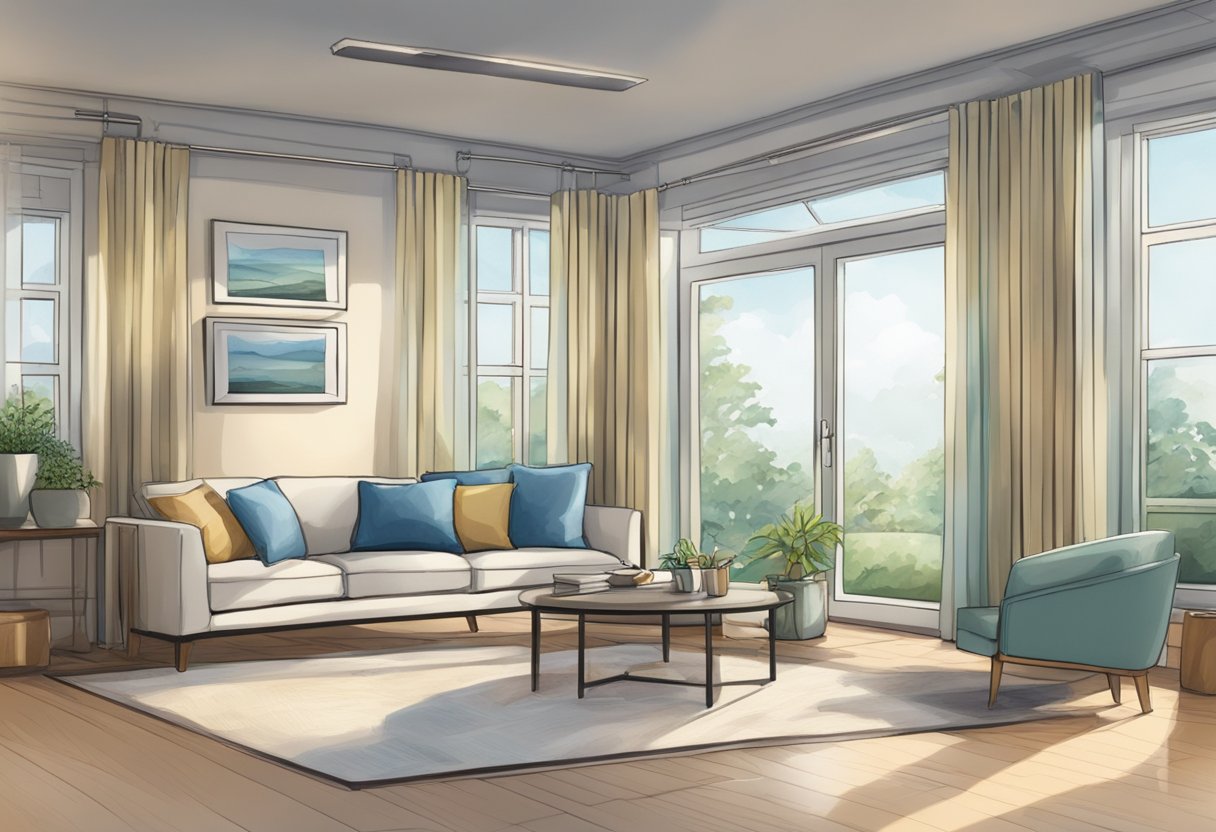
In addition to opening doors and windows, you can also use fans in the surrounding areas of the house. Place a fan near the open window to draw in more outdoor air and push it toward the windowless room. This will help increase air movement and make the space feel more comfortable.
By following these steps, you can successfully improve air circulation in a room without windows and maintain a fresher environment in your home.
Add or use a ceiling fan
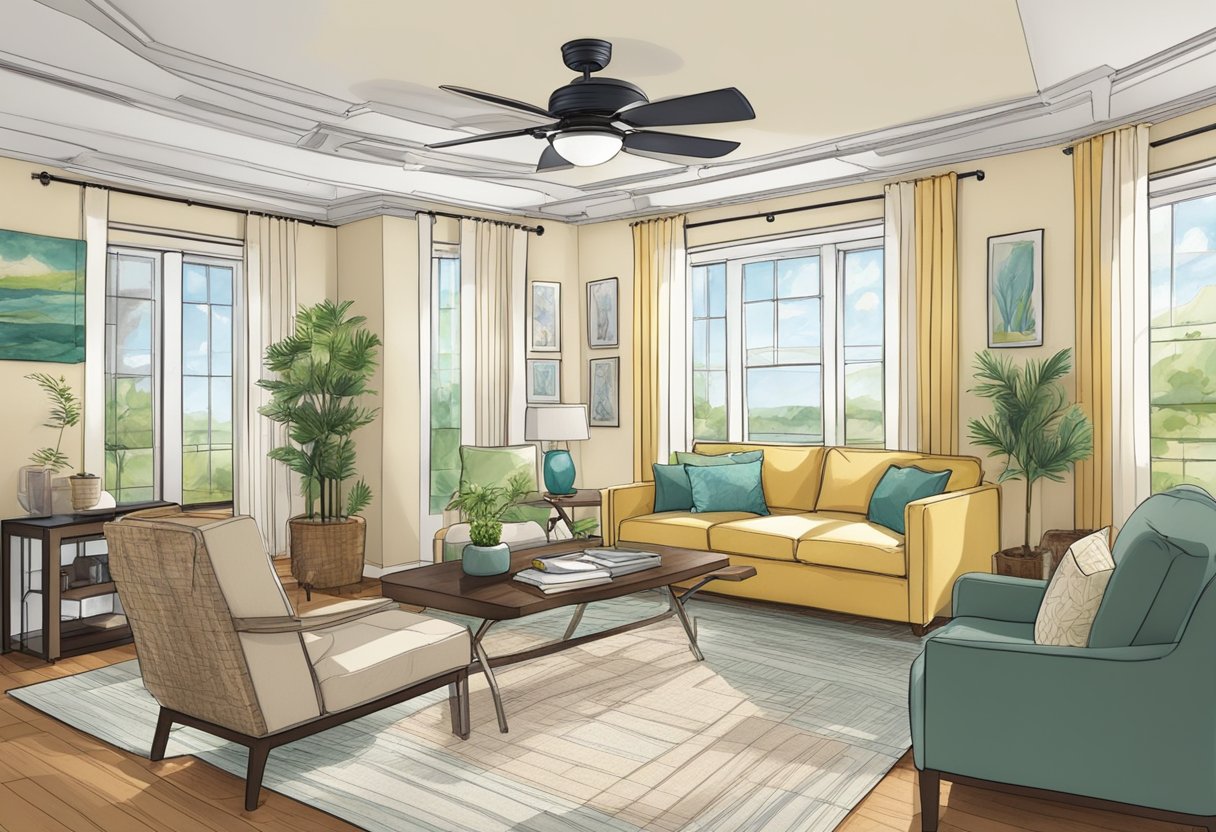
Installing a ceiling fan enhances air circulation in windowless rooms by promoting continuous air flow and dispersing stale air. These work best if the room temperature is okay but you just need some air movement.
To select the right ceiling fans:
- Choose based on room size, ensuring an appropriate CFM rating.
- Opt from standard, low-profile, or hooded vent fans.
- Install as per manufacturer guidelines, ensuring a secure mount.
- Operate at moderate speeds for best airflow.
- Complement with portable fans, like doorway or vent fans, for increased circulation.
- For efficiency, position doorway fans at the door’s top and vent fans at exhaust points.
- Regularly clean all fans to maintain performance.
By using ceiling and portable fans, you can achieve better air circulation in windowless rooms.
Add or use a portable fan
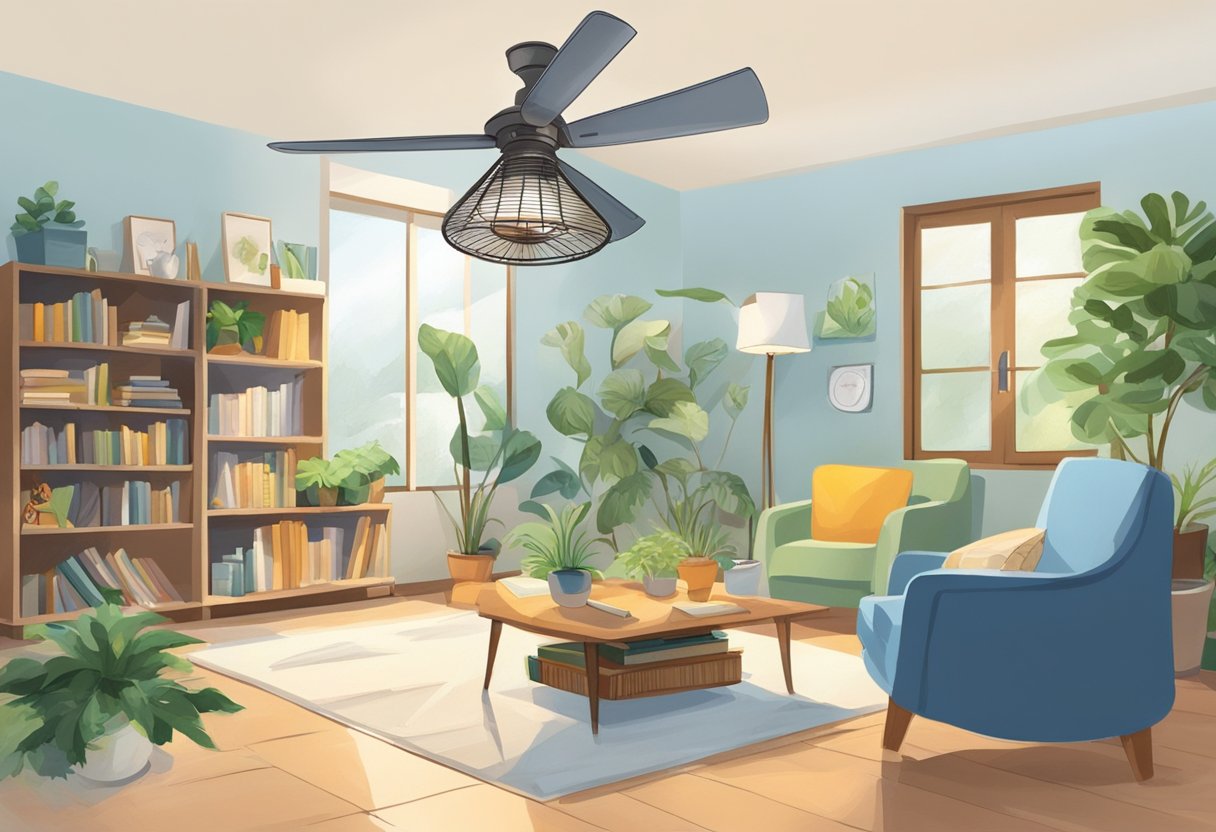
A portable fan can significantly improve the air circulation in a room without windows. These fans come in various sizes and styles, including standing fans, desk fans, and box fans. To optimize air circulation, place a portable fan near a doorway or an open area, directing the airflow towards the center of the room.
Here are some steps you can take to improve air circulation using fans:
- Choose the right type of fan for your room. Consider the size, style, and available space when selecting a portable fan
- Position the fan strategically. Place it near a doorway or opening for the best results.
- Keep the fan clean and well-maintained. Regularly dust and clean the fan to ensure it operates efficiently and provides optimal air circulation.
- Adjust the fan settings as needed. Depending on the type of fan, you may have options for fan speed, direction, or mode.
Add a Portable Air Conditioner
A portable air conditioning system is an effective way to improve air circulation in a room without windows. These units are compact, easy to install, and can be moved around as needed.
Here’s why using a portable air conditioner is a good choice to increase ventilation:
- No window needed: Unlike window AC units, portable air conditioners don’t require a window for installation. They only need a small vent hose to be directed outside or to another room, efficiently removing heat and increasing air circulation.
- Efficient circulation: Portable air conditioners come with built-in fans that help circulate cool air around the room. This constant flow of air ensures better ventilation and minimizes the chances of stagnant air or hot spots in the room.
- Air filtration: Most portable air conditioning units have air filters that help remove dust, allergens, and pollutants. This not only improves the air circulation in the room but also makes the air you breathe cleaner and healthier.
To make the most out of your portable air conditioner, follow these simple steps:
- Choose the right size: Select a unit with the appropriate BTUs (British Thermal Units) based on your room’s size. A higher BTU rating means more cooling capacity, but also a larger unit and higher energy consumption.
- Pick a suitable location: Place the portable AC unit near an exterior wall or door where the vent hose can be easily directed outside. Keep the unit away from direct sunlight or heat sources to maximize energy efficiency.
- Set up the ventilation: Connect the vent hose to the unit and ensure it’s securely directed outside or to another room. Portable air conditioners typically come with a window installation kit, but if your room has no windows, you can use a door or an adjacent room as an alternative.
- Maintain the filters: Regularly clean or replace the air filters as recommended by the manufacturer. Clean filters improve air circulation and maintain the unit’s efficiency.
Remember that although portable air conditioners help to improve air circulation, they are primarily designed to cool a room.
Use a dehumidifier
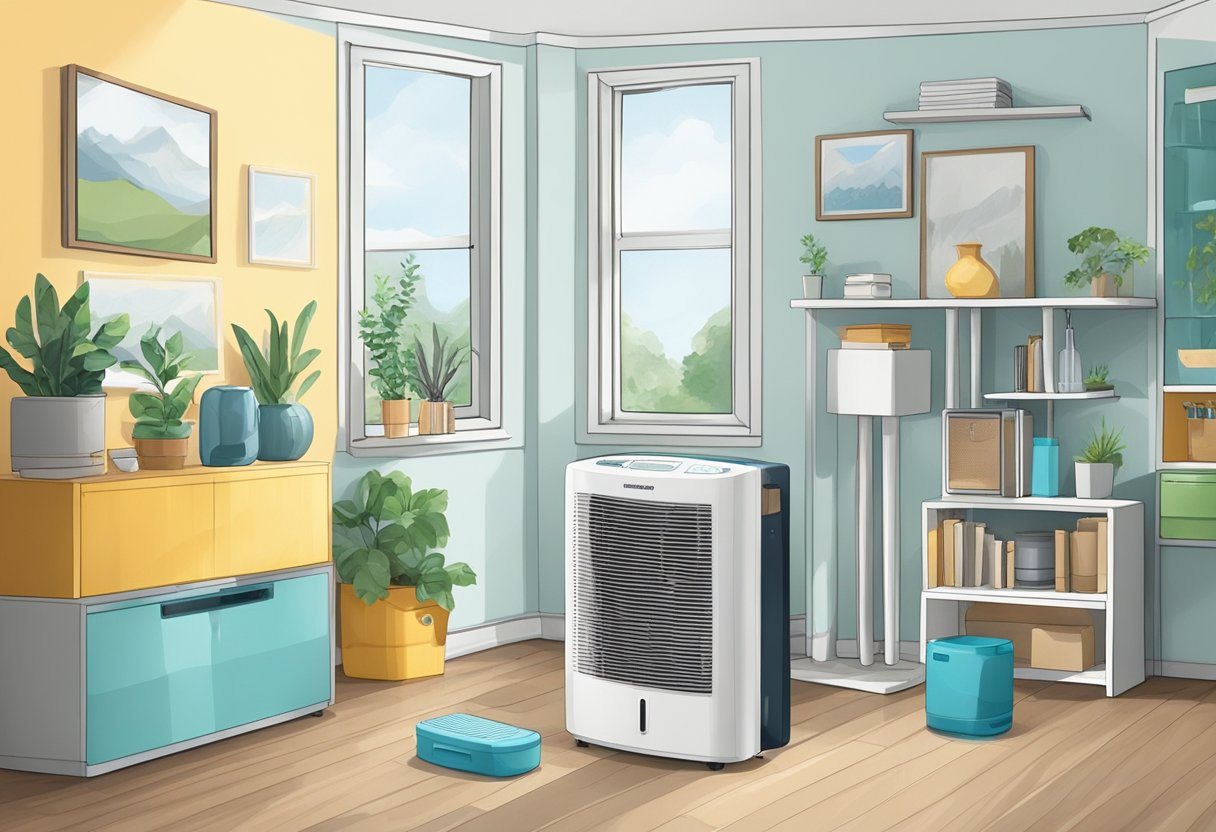
A dehumidifier can work wonders in improving air circulation in a room without windows. By extracting moisture from the air, dehumidifiers can help improve stuffy and humid air in a room as well as reduce dampness or condensation in windowless spaces.
When you use a dehumidifier, it reduces the humidity levels, making the air feel lighter and more comfortable. This is beneficial in a room without windows as it can prevent the buildup of stagnant air and promote better circulation. As a result, you’ll experience a fresher atmosphere.
To make the most out of a dehumidifier, here are a few steps to follow:
- Choose the right size: Dehumidifiers come in various sizes and capacities, suitable for different room sizes. Select a unit that matches the size of your windowless room for optimal results.
- Select the appropriate humidity level: Most dehumidifiers have adjustable humidity settings. Aim for a relative humidity of around 30-50% to ensure a comfortable environment.
- Regularly empty the water reservoir: Dehumidifiers collect water in a reservoir, and it should be emptied regularly to maintain maximum efficiency.
- Clean and maintain the unit: Regularly clean the filter and other components of the dehumidifier to keep it operating effectively.
By following the simple steps above, you can optimize the dehumidifier’s performance and maintain a fresher, more breathable space.
Use a Portable Air Purifier
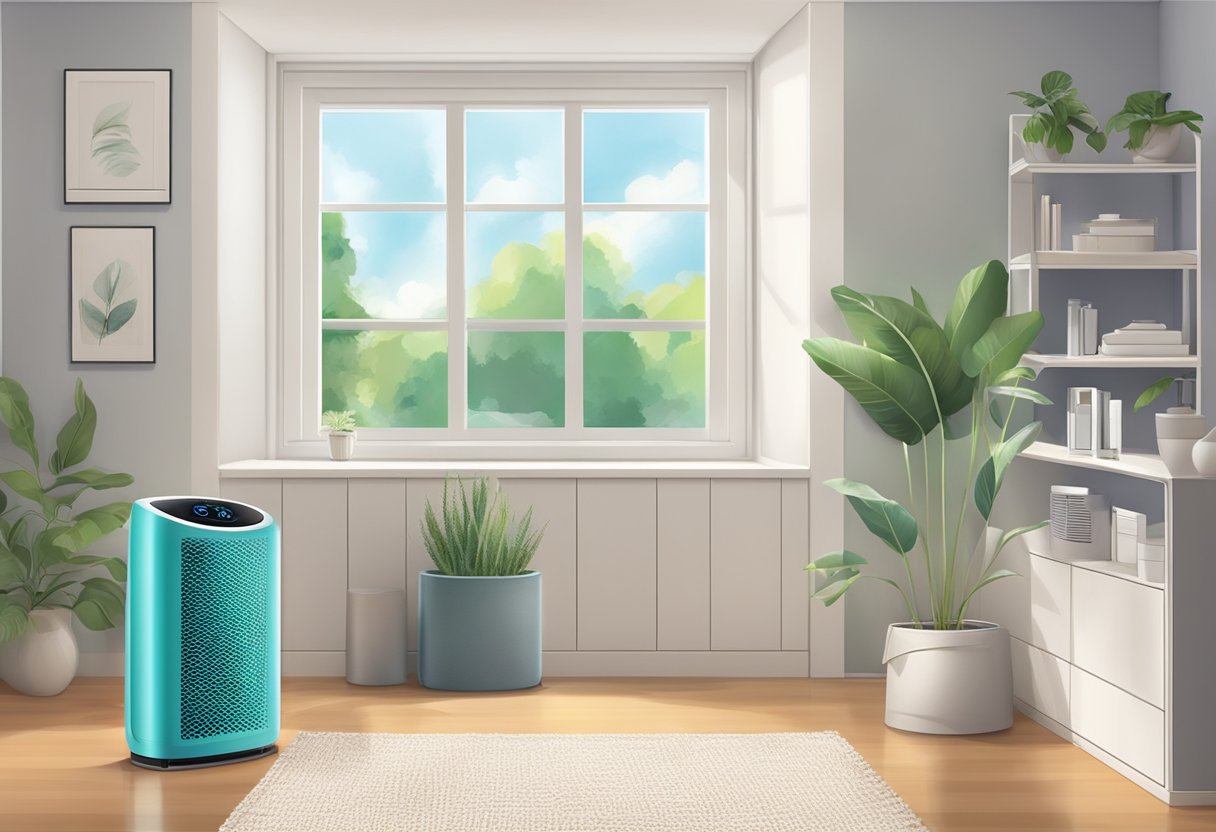
A portable air purifier is an excellent solution to improve air circulation in a room without windows. These devices, also known as air cleaners or air sanitizers, are designed to filter the air in a single room or area, removing pollutants and allergens.
Benefits of Using a Portable Air Purifier:
- Air filtration: A portable air purifier can effectively filter out pollutants, allergens, and other contaminants, helping you breathe cleaner air indoors.
- Reduced odors: By removing airborne particles, an air purifier can also help combat unpleasant odors in a room without windows.
- High-efficiency particulate air (HEPA) cleaner: HEPA filters are proven to capture up to 99.97% of airborne particles as small as 0.3 microns, making them a top choice for air purification.
How to Choose a Portable Air Purifier:
- Determine your room size: Measure the square footage of your room to choose an air purifier with a suitable coverage area.
- Select the type of air filter: A true HEPA filter is the gold standard for air filtration, but other types, like activated carbon filters and pleated filters, can also be effective. You can also opt for a combination filter to target specific contaminants.
- Consider the noise level: Choose an air purifier with an acceptable noise level, especially if you plan to use it in a bedroom or office.
- Maintenance requirements: Look for air purifiers with easy-to-replace air filters and minimal maintenance needs to ensure longevity and effectiveness.
It’s important to change your air purifier’s filter according to the manufacturer’s recommendation, as this will maintain its efficiency.
Install an exhaust or ventilation fan
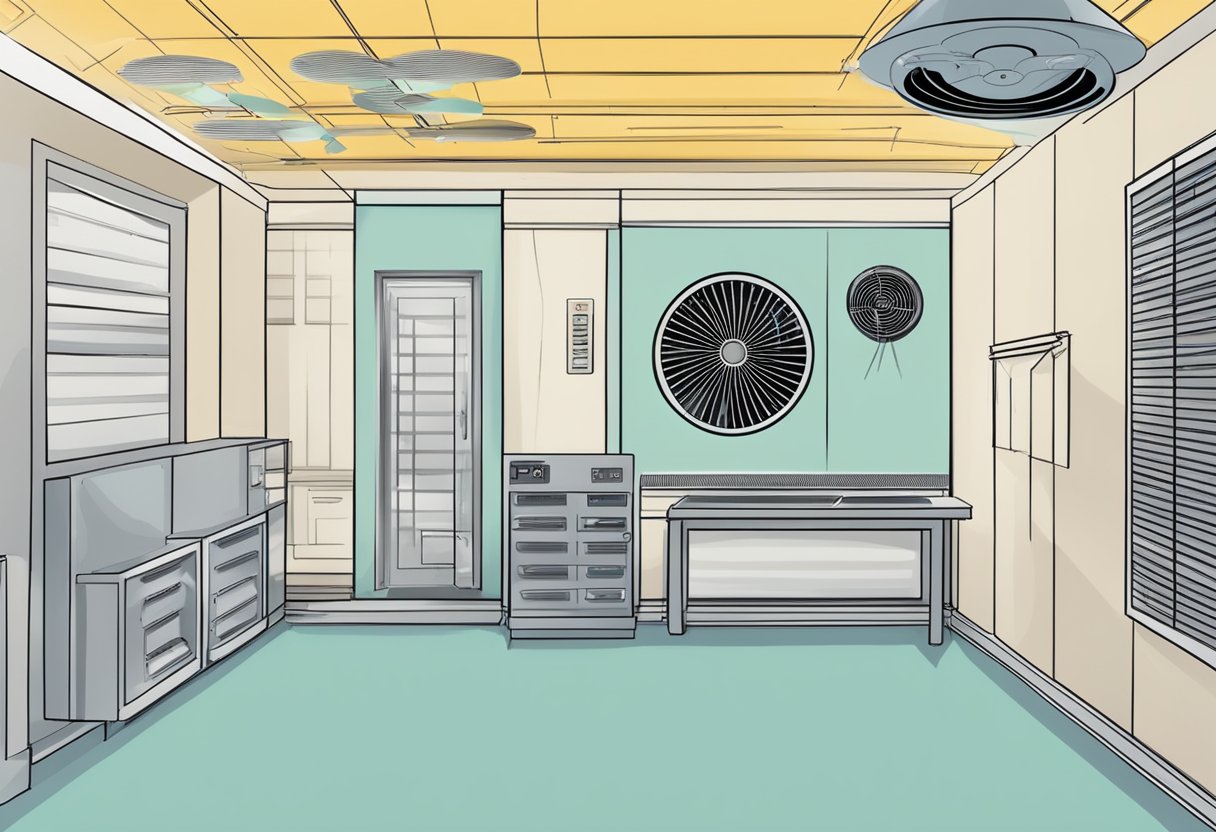
What is a ventilation, exhaust, or extractor fan? Well, basically it is the same thing that you’ll typically find in the bathroom – it pulls air from the room and sends it up into the attic or perhaps out through the roof.
Installing an exhaust or ventilation fan in a windowless room can significantly improve air circulation for several reasons:
- Removal of Stale Air: An exhaust or ventilation fan actively draws out stale air from the room. In a windowless room, there are limited outlets for the air to naturally circulate out. The fan helps in expelling this trapped air, allowing for a continuous flow.
- Influx of Fresh Air: As the stale air is drawn out, it creates a negative pressure within the room. This can lead to fresh air from adjacent rooms or vents being pulled into the windowless room, ensuring a constant supply of fresh air.
- Reduction of Humidity: Windowless rooms, especially bathrooms or kitchens, can accumulate humidity. An exhaust fan helps in reducing this moisture, preventing mold growth and creating a more comfortable environment.
- Elimination of Odors: Without proper ventilation, odors can linger in a windowless space. The fan helps in extracting these odors, ensuring the room smells fresher.
- Temperature Regulation: The fan can help in extracting warm air, especially in spaces like kitchens where heat might be produced. This can make the room feel more comfortable and also reduce the load on air conditioning systems.
- Prevention of Contaminant Build-Up: In some windowless spaces, like bathrooms, contaminants such as mold spores can grow. By ensuring proper air circulation, exhaust fans can reduce the concentration of these pollutants.
However, keep in mind that exhaust fans will be pulling air from inside and sending it outside so if you are running your air conditioner it will just send out the air conditioned air, potentially impacting the temperatures in the house.
Why is airflow and ventilation important in the home?
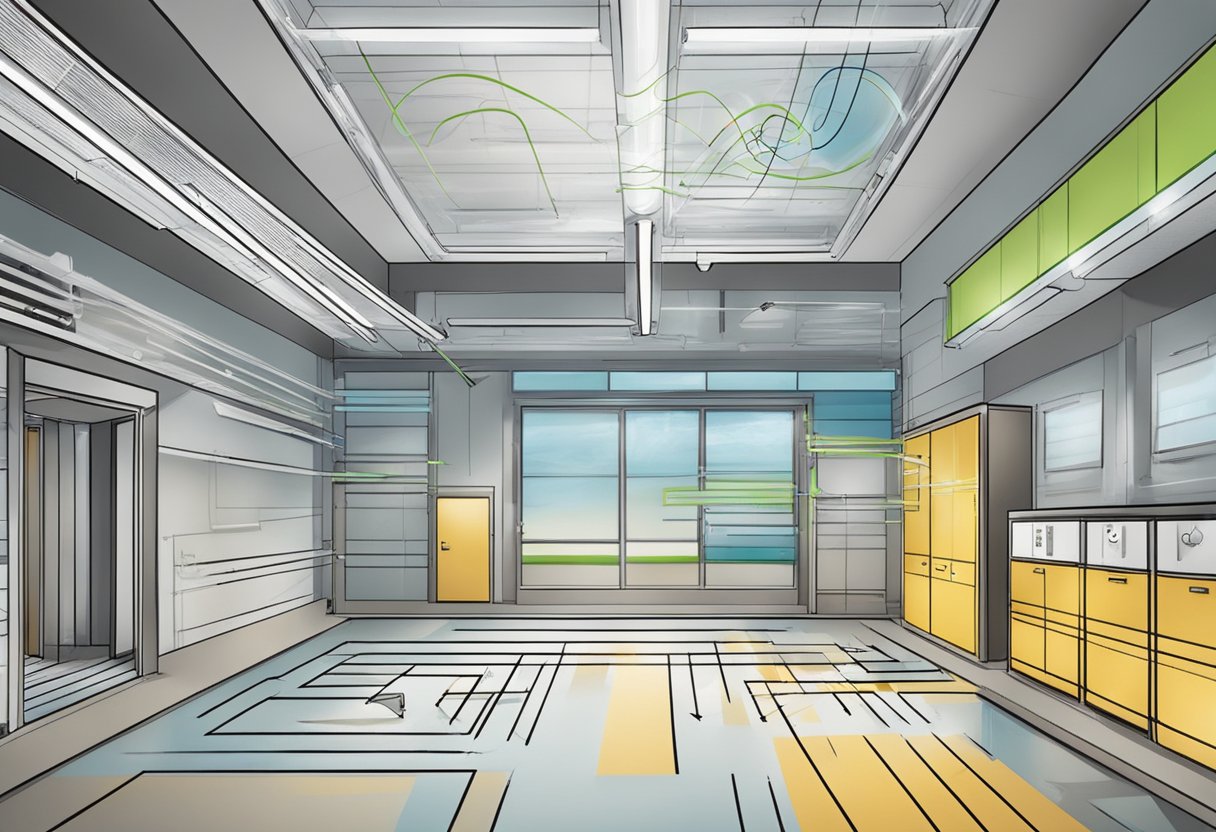
Airflow and ventilation are essential in maintaining good indoor air quality and contributing to a healthy living environment in homes.
Proper ventilation helps to remove stale air, pollutants, allergens, excess moisture and odors, while allowing fresh air to circulate, creating a more comfortable and safe space for you and your family’s health.
The most common problem areas in the home
Some areas in your home may be more prone to poor ventilation than others, including:
- Bathrooms: High moisture levels can lead to mold and mildew growth which can trigger allergies and respiratory issues.
- Kitchens: Cooking fumes, smoke, and odors can build up without proper ventilation, affecting indoor air quality.
- Basements and crawl spaces: These spaces are often poorly ventilated, leading to dampness, musty odors, and the potential for mold growth.
- Bedrooms: Poor ventilation can result in increased dust, allergens, and stale air, making it difficult for a restful sleep.
How to control humidity and condensation
Controlling humidity and condensation is an essential aspect of maintaining good ventilation in your home. Here are some tips to help you manage these issues:
- Use exhaust fans: Install and use exhaust fans in high moisture areas like bathrooms and kitchens to remove excess moisture and fumes.
- Dry clothes properly: If possible, dry your clothes outdoors or use a vented dryer to prevent excess moisture buildup indoors.
- Maintain your HVAC system: Regularly clean and maintain your heating, ventilation, and air conditioning (HVAC) system to ensure optimal airflow and humidity control.
- Use a dehumidifier: In areas prone to high humidity, consider using a dehumidifier to reduce moisture levels.
- Seal windows and doors: Ensure windows and doors are well-sealed to prevent drafts and condensation.
Incorporating good ventilation practices, whether through natural or mechanical means, is crucial in maintaining a healthy and comfortable home environment. Remember to focus on problem areas and control humidity and condensation to achieve optimum indoor air quality.
Let Us Know How We’re Doing!
Did this expertly prepared resource answer your question?
Do you have another question about home maintenance, home improvement projects, home appliance repair, or something else?
Get more information, send in questions and keep the discussion going by contacting the I’ll Just Fix It Myself company customer service team at at 1-800-928-1490 or Email us at [email protected]
